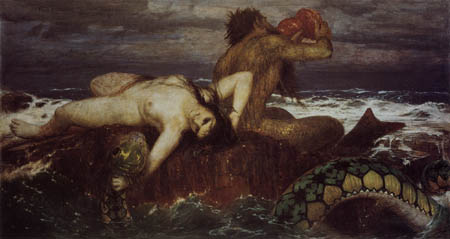The actions in the video are great, an absurd concept carried out to perfection. The idea of a blind guy driving and crashing into the car in front of him is successful because of its simplicity. It is clever, but not over the top. A middle ground is tread upon, and a deadpan approach underscores the blend of clever and simple. A great deal of restraint is also shown. Skits are never allowed to be taken too far. But what really makes the video and many others is the responses of the people who are inadvertently involved in such spectacle. It could be argued that the reaction is actually more important than the actual activity. Would the activity exist without the people around who will react to it? By the way, I know what you are thinking. Who links Jackass on a blog like this? Well, I am reminded of a game Robert Venturi used to play with Denise Scott Brown: "I can like something worse than you can like."
 The AT&T Building By Philip Johnson, when first constructed was very confrontational. It opened up the floodgates for the fight between the Modernists and the PostModernists. I will not get into the specifics of this fight, although there were some nasty things tossed back and forth, with each side accusing the other of things like Nazi sympathizing. Much like contemporary politics! Each side criticized the other, both with their work, and their words. Charles Jencks calls this "Critical Modernism." All -Modernisms exist simulataneously and criticize each other. PostModernism is one of those -Modernisms. The modernists called PostModernism among other things "architectural AIDS" and "transvestite architecture."
The AT&T Building By Philip Johnson, when first constructed was very confrontational. It opened up the floodgates for the fight between the Modernists and the PostModernists. I will not get into the specifics of this fight, although there were some nasty things tossed back and forth, with each side accusing the other of things like Nazi sympathizing. Much like contemporary politics! Each side criticized the other, both with their work, and their words. Charles Jencks calls this "Critical Modernism." All -Modernisms exist simulataneously and criticize each other. PostModernism is one of those -Modernisms. The modernists called PostModernism among other things "architectural AIDS" and "transvestite architecture."
Triton and Nereide, 1873-4
"With your small painting of the sirens you have provoked in Basel a highly comical revolution, a life and death struggle. The so-called connoisseurs of art huddled in armies before it, with monocles and opera glasses like blowflies around sugar granules, simultaneously screaming and quarreling with one another... only when the painting left did the storm subside."

Sirenen, 1875
"It is the intention of the artist that we laugh at some of his figures, just as some of Shakespeare's characters are meant to make us laugh. Strangely enough a number of otherwise art-loving viewers seem not to be able to understand or relate to this idea. They view it as a weakness of Bocklins work if one of his figures contributes to their amusement!"
Self Portrait

No comments:
Post a Comment